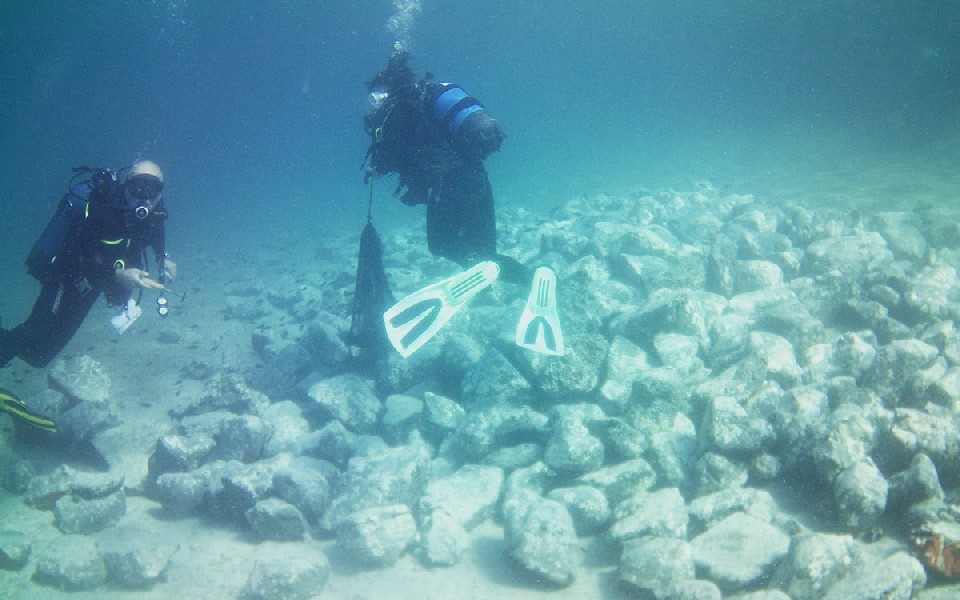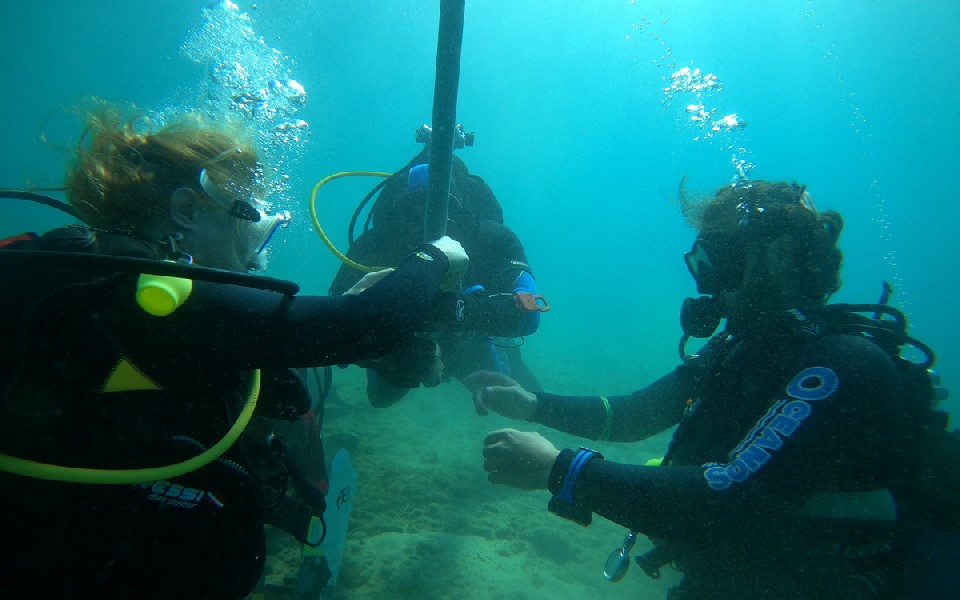Nestled within the coronary heart of the National Marine Park of Alonnisos Northern Sporades, in a picturesque bay off the coast of Kyra Panagia island, underwater archaeologists are uncovering one of many earliest prehistoric websites on the Aegean islands. Exploration of the shallow seabed surrounding the tiny, uninhabited islet of Agios Petros (St. Peter) have revealed the stays of a submerged Stone Age settlement, relationship again roughly 8,000 years to the second half of the seventh millennium BC, providing valuable perception into the lives of among the first seafaring farmers within the Aegean.
Based by a small but industrious group of farmers, fishermen, and seafarers in a interval generally known as the Early Neolithic (or “New Stone Age”), when the worldwide sea degree was 20 to 30 meters decrease than at current, the settlement of Agios Petros thrived for practically a thousand years earlier than it was ultimately deserted. These early settlers lived in small stone homes and left behind wealthy deposits of artifacts, together with painted pottery, anthropomorphic collectible figurines, and instruments made out of flint, in addition to necessary clues about their weight-reduction plan.

© Hellenic Ministry of Tradition and Sports activities / Ephorate of Underwater Antiquities
The island settlement of Agios Petros website was first excavated within the early Seventies by archaeologist Dimitris Theocharis, then Commissioner of Antiquities of Thessaly. Nonetheless, it wasn’t till 1981 that intensive analysis started, together with the primary underwater survey, underneath the path of Professor Nikos Efstratiou of the Aristotle College of Thessaloniki, in collaboration with the famend British oceanographer Nic Flemming, and members of Cambridge College’s Underwater Exploration Group. Describing its significance, Efstratiou famous, “the truth that the marine settlement of Agios Petros is preserved to this present day on the backside of the Aegean, 1000’s of years after it was based by the primary agricultural teams that arrived in Greece, makes it a particular archaeological website.”
Excavation efforts on and across the islet have unearthed a dozen stone rectangular and arched “apsidal” constructions (homes), two kids’s burial websites, and a spread of artifacts that point out the inhabitants of Agios Petros, which possible numbered a number of household teams, weren’t remoted from the surface world. Due to various kinds of painted and incised ceramics and collectible figurines, the settlement possible traded, immediately or not directly, with neighboring areas comparable to Thessaly on the Greek mainland, the southern Aegean islands, the Balkans, and Anatolia, highlighting the rising cultural networks that crisscrossed the Aegean in the course of the Early Neolithic.
Efstratiou emphasizes the significance of this website within the broader context of the unfold of Neolithic lifeways within the area, noting, “it permits us to research necessary points in regards to the historical past of the island, the habitation within the Aegean, and the pure surroundings that the primary islanders noticed.”
Peeling Again the Layers
In 2021, Efstratiou and his staff launched “Farmers at Sea,” a brand new five-year analysis program (2021-2025) to additional discover the submerged website of Agios Petros, with the assist of the Hellenic Ministry of Tradition’s Ephorate of Underwater Antiquities. Endorsing this newest spherical of analysis, Nic Fleming, who co-directed the primary underwater survey in 1981, stated “New work is required with fashionable strategies and diving gear to seek out the complete extent of the submerged settlement, to excavate sequential stratigraphic layers figuring out the tradition at completely different dates, and to review how the settlement grew to become submerged within the sea.”
Working at depths of 5 to 7 meters, divers have fastidiously documented seen archaeological options and artifacts, together with a number of stone partitions and deposits of pottery.
Earlier terrestrial excavations on the islet revealed meals stays, together with varied species of home animals (sheep, goat, pigs, cows), hunted animals (deer), fish, shellfish, and birds, additional demonstrating the combined economic system that sustained the group. The mixture of looking, animal husbandry, fishing and seafaring made Agios Petros a resilient society, able to adapting to the distinctive challenges of island life. The present venture additionally hopes to uncover additional particulars about the character of early seafaring within the Aegean. As Efstratiou explains, “We’re additionally on the lookout for clues that may enlighten us in regards to the practices of early navigation within the Aegean, such because the kinds of boats utilized by the primary islanders.”
One other intriguing side of the continued analysis is the seek for historical human DNA, which might present new insights into the genetic make-up and origins of the Agios Petros inhabitants. Efstratiou provides, “Analysis is targeted on finding historical human DNA and opening check sections on the factors the place surviving architectural stays have already been recognized.”

© Hellenic Ministry of Tradition and Sports activities / Ephorate of Underwater Antiquities
Rising Seas and the Sinking of Agios Petros
In contrast to different submerged websites within the Mediterranean, the sinking of Agios Petros was not brought on by a sudden geological disaster. As an alternative, the settlement was progressively engulfed by the ocean as water ranges steadily rose within the aftermath of the final Ice Age, prompted by the climatic adjustments that occurred someday round 6,400 BC. “The method of the gradual sinking of the settlement of Agios Petros is a totally pure course of associated to the continual rise of the ocean degree and never on account of some dramatic geological phenomenon,” Efstratiou clarifies. On the time of the settlement’s institution within the late seventh millennium BC, the islet was linked to Kyra Panagia by a peninsula, which is now totally submerged.
The gradual submersion of the location has helped protect its historical stays, offering archaeologists with a uncommon snapshot of an Early Neolithic island group frozen in time. The continued excavation of Agios Petros is revealing new layers of knowledge with each dive, providing an unparalleled glimpse into the maritime and agricultural lifetime of the Aegean’s earliest farmers.
Neolithic Networks within the Aegean
The research of Agios Petros and different submerged websites within the Aegean helps to reshape our understanding of the unfold of Early Neolithic lifeways throughout the japanese Mediterranean. The rise of agriculture within the Fertile Crescent of the Close to East, together with the domestication of crops and animals, spurred the dispersal of farming communities westwards into Europe. Initially, students believed that agro-pastoralist teams adopted overland routes by means of Thrace and Macedonia from Anatolia, however it seems that a few of these communities took benefit of maritime know-how within the Aegean (a recognized function of earlier, Mesolithic hunter-gatherer lifeways within the area) and settled on the islands, the place they tailored their agricultural practices to coastal environments.
Agios Petros, together with different necessary Neolithic websites on Crete, the Cyclades, and the Dodecanese, exhibits how early islanders engaged in combined farming and animal husbandry, whereas additionally counting on the ocean for sustenance. The invention of hunted animal and fish stays at Agios Petros highlights the flexibility of those early farmers, who had been in a position to exploit each the land and sea for survival.
Cultural exchanges between the Aegean islands and surrounding areas, notably Anatolia, performed a key function in the diffusion of Neolithic concepts and practices. “The islet was not an remoted group however had cultural contacts with different and sometimes extra distant areas,” Efstratiou notes. The settlement’s connections to distant areas point out that Agios Petros was half of a bigger Neolithic community that linked the Aegean islands to the encompassing mainland and past.

© Shutterstock
Submerged Prehistoric Archaeology: A Rising Area
Agios Petros is only one of a rising variety of submerged prehistoric websites within the Aegean which can be offering archaeologists with invaluable knowledge about early human settlement within the area. Rising sea ranges have preserved these historical coastal communities, providing a singular alternative to review the interaction between land and sea within the early unfold of agriculture.
One of the well-known submerged websites in Greece is Pavlopetri (actually “Paul’s Stone”), off the coast of southern Laconia. Found in 1967, Pavlopetri is the oldest recognized submerged city on the earth, relationship again to the mid-4th millennium BC. Located within the slender channel between the mainland Peloponnese and the island of Elafonisos—as soon as linked to the peninsula earlier than a catastrophic earthquake severed the land—the location was completely positioned for early human settlement. Its location provided a wealth of assets, with fertile soil for farming, contemporary water, and shut proximity to the ocean. Over time, the village thrived, evolving into a vibrant fishing group and, later, a fancy city middle within the Bronze Age, aided by the pure safety supplied by its sheltered environment.
Because the archaeological investigation of Agios Petros continues for one more season in 2025, researchers hope to deepen our understanding of the early Aegean settlers and their function within the unfold of agriculture and seafaring. The location stands as a testomony to the resilience and flexibility of Neolithic communities, whose improvements laid the groundwork for the advanced societies that will emerge within the area millennia later.



Recent Comments